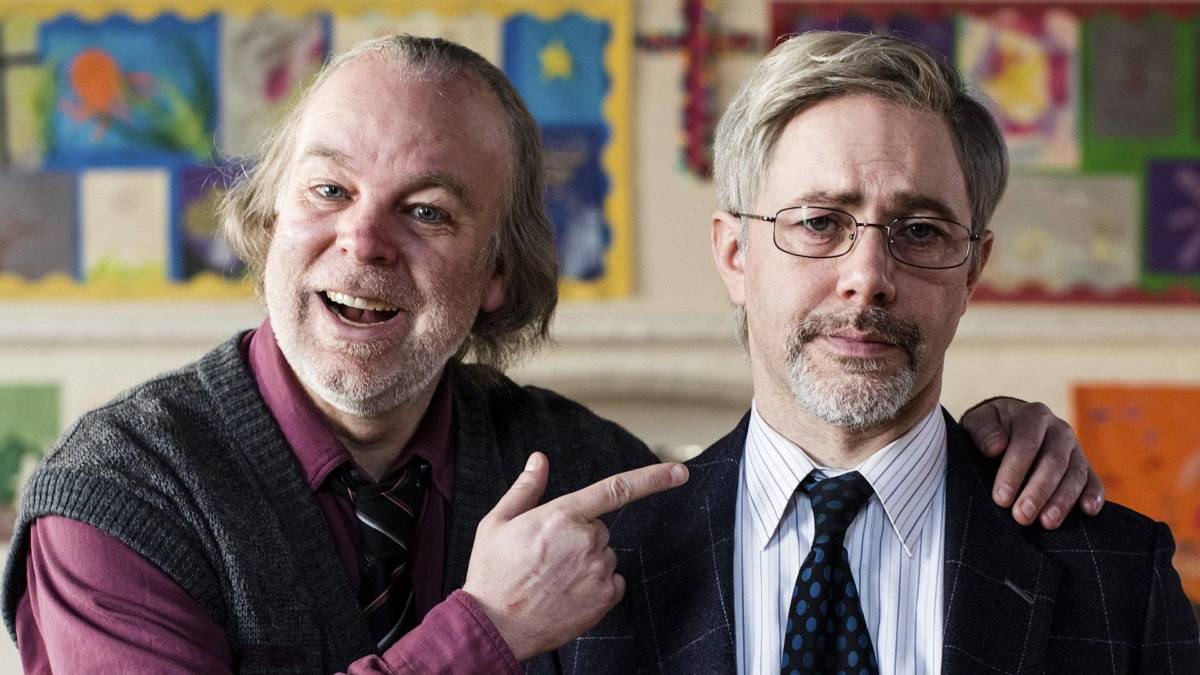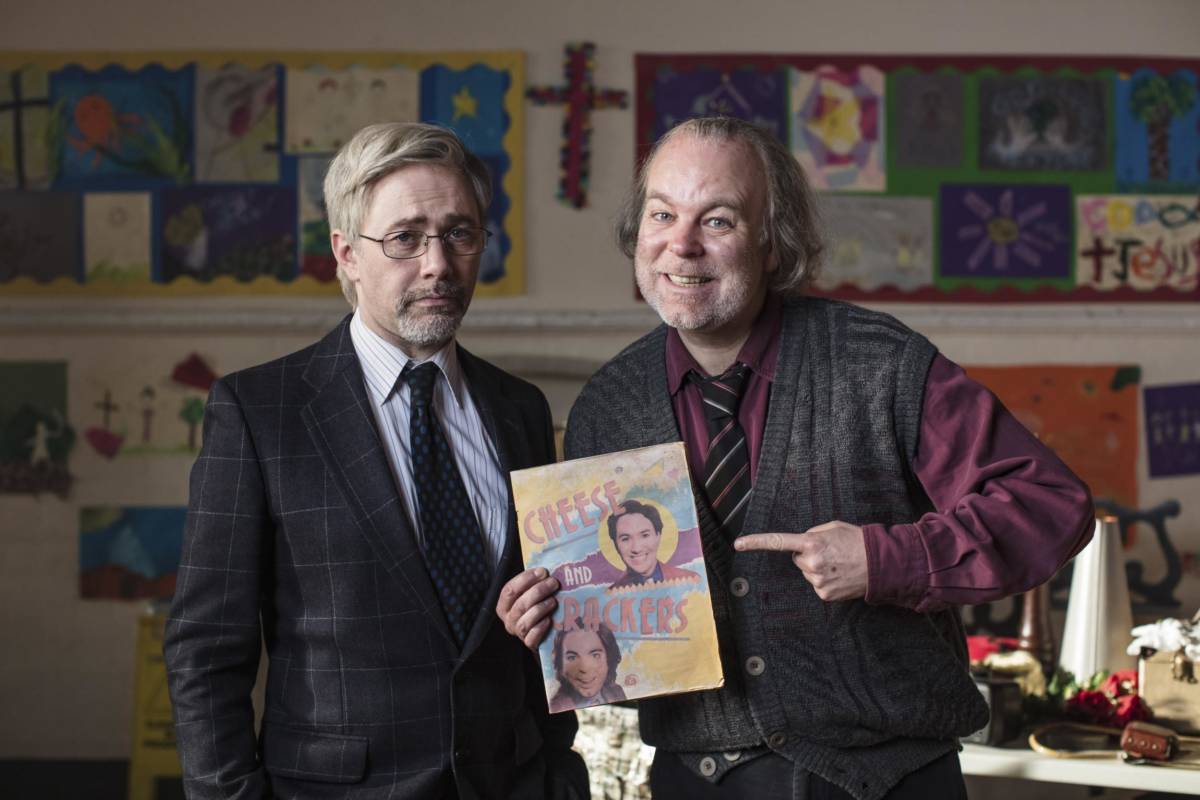Inside No. 9 is, in its way, stronger than its more popular contemporary Black Mirror – more consistent (certainly in more recent years, anyway) and more willing to leaven the proceedings with a chuckle or two, and not always insanely dark ones either. Indeed, for all that it tends towards the darker topics, it presents far more of a mixed bag than Black Mirror, which is either pitch-dark techno-fear or San Junipero. You’ve got everything from straight horror in ‘The Harrowing’, to silent comedy in ‘A Quiet Night In’ (which, appropriately, featured Oona Chaplin, granddaughter of Charlie), and even heartwrenching drama in the critically acclaimed ‘The Twelve Days Of Christine’.
Usually, however, Inside No. 9 leans towards faintly absurd bawdiness with a dark undercurrent creeping up from behind, a formula which creators and stars Reece Shearsmith and Steve Pemberton were already doing extremely well with The League of Gentlemen. Indeed, season 3’s ‘The Bill’ flew very close to the Geoff, Mike, and Steve sketches from The League, dealing as it did with some ordinary blokes, out for a meal, who turn a something-and-nothing issue into unbearable tension – although The League managed to make it a punchline when the tipping point came, with Geoff flying into a rage and declaring “You know I’ve got this gun, don’t you?”
‘Bernie Clifton’s Dressing Room’ is another episode of this kind – and it too could be compared to sketches from The League, specifically the ‘Legz Akimbo’ sketches, which followed a particularly hapless school theatre troupe. If the wider world of British acting was a family tree, school theatre is a genetic dead end, a seldom-spoken-of cadet branch that lives out in the middle of nowhere and probably has more toes than is usual. ‘Bernie Clifton’s Dressing Room’, however, deals with the sadder story of the variety comic double-act – which is still knocking around, but has fallen from some lofty heights, like some senile country laird who mumbles out a plan to take the horses out round the top field, only the horses are dead and the top field was turned into an out-of-town supermarket long, long ago. For a send-up of the genre that also acts as a summary, observe Mitchell and Webb’s ‘Fish and Cushion’ sketch (which, as it leans heavily on the introduction of the ‘chip and PIN’ payment system, is now dated in two ways).

The double-act can trace its lineage back to the British music-hall tradition, and its transatlantic cousin vaudeville. Typically the comedy duo would be just one of a number of different performances on the bill (and this was in the days when that could cover everything from lion-taming to minstrels), and could usually be divided neatly into the ‘straight man’ and ‘funny guy’, archetypes which are still familiar today. The advent of film siphoned off both audiences and talent from these live shows, with the most famous example probably being the legendary Laurel and Hardy.
Still, despite the rise of the mass media, live comedy still had its place, and for double-acts the ‘straight man’/’funny guy’ formula remained fairly ubiquitous until the 1960s, with the advent of The Two Ronnies and with Morecambe and Wise tinkering with the formula under writer Eddie Braben. While this setup still exists, more modern acts like Key and Peele have both performers flipping and flopping between being the funny one, or even both of them having a go. Many comic duos now lean more heavily on differences in status or intelligence, as in Mitchell and Webb’s characters in Peep Show, where the vainglorious stupidity of one performer will naturally prompt wry commentary from the other – which, in fairness, isn’t a million miles from how the ‘straight man’/’funny guy’ duality went in practice.
It’s important to draw a line between out-and-out comedians, and the kind of double-act satirised in ‘Bernie Clifton’s Dressing Room’, which in its way was far more of a direct descendant of the music-hall/vaudeville tradition, very often incorporating singing, dancing, or other such elements. The most visible modern-day incarnation is likely the Chuckle Brothers, who, for all they’re mocked, have been going for fifty years now, and unlike most British entertainers of that era aren’t now disgraced in some way.
The variety double-act’s fall from grace is a key element of the plot here – the two main characters, Tommy and Len, had, once upon a time, found some success as ‘Cheese and Crackers’, only to have split years ago. This was a familiar sort of name for such acts, with some real-life examples being ‘Little and Large’ and ‘Cannon and Ball’ – Len is still somewhat bitter that ‘Cheese and Onion’ was taken. The central conceit is that, after some time apart, the two are planning a one-off reunion show, yet from the off, the show’s trademark tension is in play – Tommy clearly doesn’t want to be there, quietly disdainful of Len’s enthusiasm for their campy old routines, and haughtily noting ‘they call me Thomas now’.

Getting into the rehearsals doesn’t improve matters. Tommy – and, indeed, the audience – is painfully aware throughout that many of their jokes are at best dated, and at worst un-PC enough that they couldn’t be done straight (the show itself getting away with it as meta-commentary). Len’s increasingly fragile enthusiasm and hangdog expression only brings things down further – as does their physical inability to do the ventriloquist’s dummy routine, due to their crumbling spines and hiatal hernias. And, as it’s revealed that Len still has a drink problem, things are threatening to completely give way to despair.
But the circumstances of this revelation save it – they prompt the first bright spot, even. Len has been taking subtle nips throughout, but it really comes out during the ‘ten green bottles’ routine. Drinking his way through ten bottles every night had, we’re told, always been a problem, and it causes the rehearsal to degrade into drunken bumbling and comic pissing – but, for the audience at home, it becomes the first of their routines to really hit home, and to not be undercut by Tommy’s open contempt for the act or by Len’s overplayed gurning.
This leads us into the explanation for their split, the reason why Tommy is so disdainful of it all yet does not simply leave, and the title – ‘Bernie Clifton’s Dressing Room’. In days of yore the title would have suggested some light-hearted celebrity anecdote, but now, post-Yewtree, it hints darkly at the seamy underbelly of the British entertainment industry. Here, it goes nicely down the middle. One night in the depths of Len’s alcoholism, he came very close to – to paraphrase Bernard Manning – puking himself to death. Tommy saved him (and paid £25 for the dry-cleaning) but, realising that the glamorous life of the variety double-act was causing Len’s drinking, then chose to quit.
It’s not exactly an outlandish twist, it’s no ‘the calls are coming from inside the house’ or ‘Tyler Durden’ never existed – really, it’s closer to gritty soap-opera material. It’s something the viewer might well have experienced, either themselves or through friends or family. But it takes the sting out of Len’s post-Cheese and Crackers decline – he might be homeless, but at least he didn’t die tragically young of overconsumption. And this points towards one of the indisputable strengths of Shearsmith and Pemberton’s approach to the anthology series, that before thirty minutes are up they can get the audience invested in characters they’ve never seen before.

Then Len’s daughter walks in, and brings the second twist – that this was never a reunion. It’s actually Len’s funeral, and Tommy has been having it out with him in his mind. That’s right, it’s the old ‘he was dead all along’ twist, just like in The Sixth Sense (a film which achieved such popularity that the twist is now considered one of the oldest in the book), or, indeed, previous episodes ‘Tom and Gerri’ and ‘The Twelve Days of Christine’. But it would be a misstep to criticise the episode for busting out an old chestnut like this – it’s about old chestnuts. Yes, the variety double-act is clichéd to its bones, it’s an old genre that’s been done and redone and done backwards and upside-down. That doesn’t mean it’s worthless. There’s a reason things become clichéd, after all, and it’s not because nobody liked them in the first place.
The temptation these days, now that we know better, might have been to dedicate the entire episode to retrospectively tearing down the legacy of politically incorrect acts from the ‘70s – and yes, there’s a bit of that at the beginning, but that’s for context. Shearsmith and Pemberton rise above that and make it an elegaic love letter to the entire genre, via one man’s remembrance of his old friend. Just as the double-act owes a debt to the music-hall, Shearsmith and Pemberton owe a debt to the double-act, particularly now they’re operating as one – beneath the Hammer Horror-inspired darkness and the twist endings, they are and always have been gag-crackers who wouldn’t have been immensely out of place onstage in sequined jackets.
To crown it all, Tommy discovers a letter addressed to him in Len’s effects, finally paying back that £25 – and then Len joins him one last time for a song and dance routine, ‘Tears of Laughter’. And I repeat, even having known these characters for a mere half an hour, this kind of showmanship feels completely earned. Really, the show couldn’t – and shouldn’t – have ended any other way.
Some of the coverage you find on Cultured Vultures contains affiliate links, which provide us with small commissions based on purchases made from visiting our site.

